Aloe bowiea
Aloe bowiea Schult. & Schult.f.
Family: Asphodelaceae
Common names: Coega dwarf aloe, Bowie’s aloe (Eng.); kleinaalwyn (Afr.)
Introduction
Aloe bowiea is very distinctive and uncommon amongst the species of Aloe, with very small, grass-like leaves and inconspicuous flowers. Its habitat is disappearing under houses and factories, and the plants are used in the domestic and international horticulture trade and wild plants are being illegally collected or stolen, which has put the Coega dwarf aloe on the endangered list.
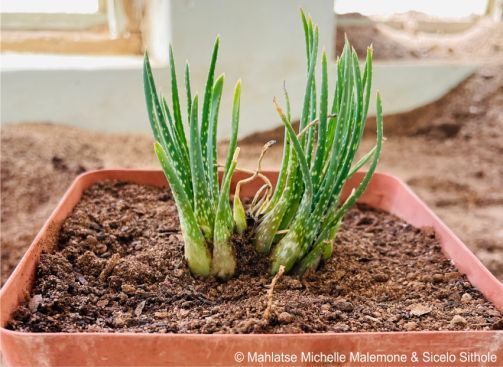
Description
Description
The Coega dwarf aloe is a small, stemless aloe, growing 70–100 mm tall or at most to a height of about 140 mm. The leaves are present all year round, they are fleshy, small, linear (long and narrow), 70–125 × 4–15 mm. Many leaves form a rosette that suckers from the base to form dense, mat-like colonies up to 500 mm wide. Solitary specimens are infrequently encountered. The leaf margins (edges) are armed with conspicuous (noticeable), tiny, white teeth that look like minute white spikes, but they are not sharp. The base of the leaf is broad, however it narrows to a very slim, and wiry or curly tip, making each rosette appear more like a bulbous plant than an aloe. The colour of the leaves is pale green, and they have white to light green longitudinal lines on the upper surface and small white spots on the underside, the spots may be raised or have minute spines.
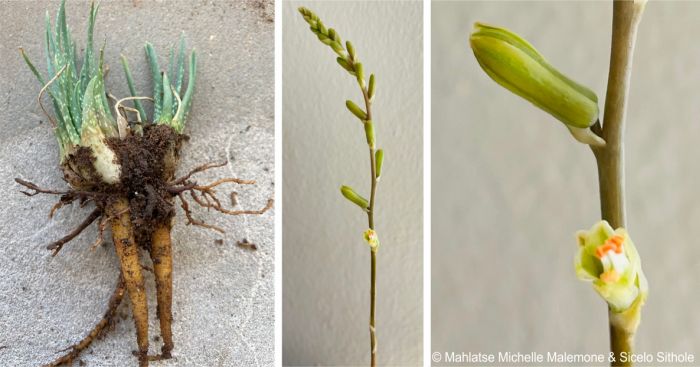
The inflorescence is simple (unbranched), growing 150-400 mm tall, bearing about 20 flowers that are tiny, 8–15 mm long, cylindric, dull greenish white, with stamens and stigma exserted. The fruit is a 3-chambered capsule, up to 12 × 4 mm, containing 3 mm long, shortly-winged, brownish-grey seeds. Flowering occurs mainly during summer (Dec. to Mar.) but flowers may be seen at any time of the year.
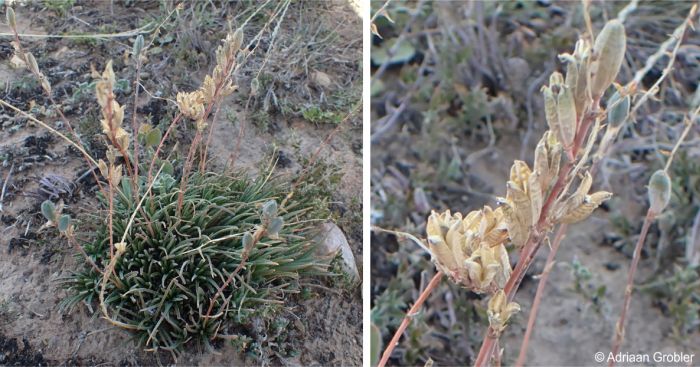
Conservation Status
Status
Aloe bowie is assessed as Endangered (EN) in its natural habitat as a result of urban and industrial expansion and over-collection. Between the years 2003 and 2018, field observations by the Custodians of Rare and Endangered Wildflowers (CREW) showed that two of the three remaining subpopulations occur in critically degraded areas on the outskirts of urban areas, where overgrazing, unlawful dumping and unlawful succulent collection is occurring, causing an ongoing decline in the wild population.
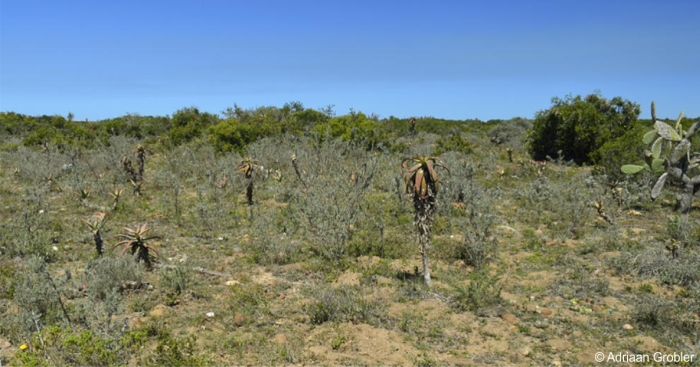
Distribution and habitat
Distribution description
Aloe bowiea is confined to a small area of the Eastern Cape province, around Gqeberha (formerly Port Elizabeth) and Kariega with over 90% of the population occurring between Uitenhage and Coega Kop, and only one other small subpopulation close to Kirkwood. It is found at altitudes not far from sea level up to 100 m, in valley bushveld vegetation, in Motherwell Karroid Thicket, Sundays Valley Thicket and Baviaans Valley Thicket habitats. Aloe bowiea is regarded as an element of karroid patches. Where this vegetation has not been damaged or degraded and is, therefore, in pristine condition, it creates very thorny and impenetrable thickets, and Aloe bowiea grows in open areas between the thickets.
Aloe bowiea grows in rocky outcrops, on level to southwest-facing slopes and in crevices, in soils that vary from sandy, to loam to heavy clay, and is often seen growing among grasses and other succulents. The climate in this region of the Eastern Cape is generally warm in summer and mild in winter with rain all year but mostly during the summer months. It can be hot and dry in summer and very wet at times. Thus Aloe bowiea, thanks to its changeable and varied habitat, is a very adaptatable and resilient plant.
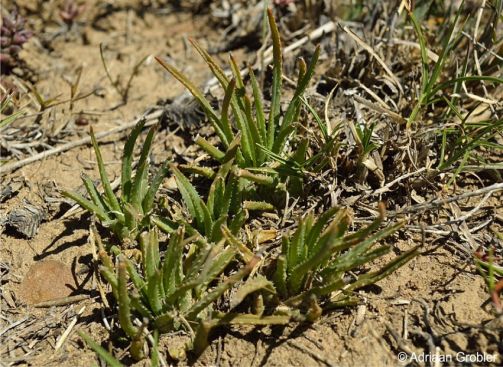
Derivation of name and historical aspects
History
The name Aloe is derived from the Arabic, alloch and translated as allal in Greek and Hebrew, which means ‘bitter sap’, which describes aloe sap. Aloe is a genus of 590 accepted species of flowering succulent plants. Aloe bowiea was first described as Bowiea africana, by the English Botanist Adrian Haworth, in 1824, and who also named Bowiea myriacantha. However, two years later both species were transferred to Aloe by the Austrian botanists Josef August Schultes and his son Julius Hermann Schultes, in 1829. Because there was already a species called Aloe africana they gave it a new specific epithet, naming this species after James Bowie (1789–1869), a plant collector who sent a living specimen to the Royal Botanic Gardens Kew, England. In 1905 Alwin Berger moved Aloe bowiea into the genus Chamaealoe, but Gideon Smith moved it back into Aloe in 1990 and reinstated Haworth’s Bowieae as a subsection of section Graminialoe.

Ecology
Ecology
There is no information on the pollination biology of Aloe bowiea. The seeds are small, light in weight, with short wings and are probably dispersed by wind.
Aloes are well-adapted to the often arid conditions found in their natural environment. Their succulent leaves store water and enable them to survive prolonged periods of drought.
Many Aloe species occur in environments that are prone to regular fires and the plants use various strategies to survive these fires. Some aloes are resprouters, where fires damage or completely kill the above-ground parts, but the plants have a thick underground rootstock that survives and resprouts. Other aloes survive fires by growing in fire-protected habitats, such as rocky outcrops, where the fire is not as severe as in the surrounding vegetation. Also, their fleshy leaves resist burning and are slow to catch fire, although they may be scorched and damaged. Many stemmed aloes retain their old dry leaves around their stem and this acts as an insulator against the heat of fires. Aloe bowiea has thick, spindle-shaped roots, fleshy leaves and grows in dense mats, their strategy may be to resist burning as far as possible, and to resprout when damaged.
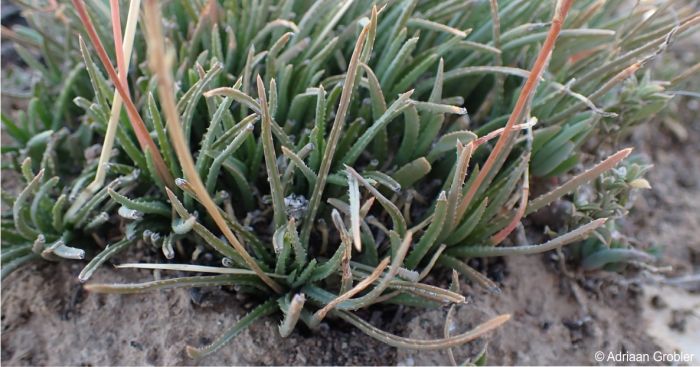
Uses
Use
Although there are no records of Aloe bowiea being used in traditional medicine, many South African aloes are used for their healing sap and it is possible that it may be similarly used. In the Eastern Cape Aloe arborescens, Aloe ferox and Aloiampelos tenuior leaves are commonly used to treat stomach ailments, fever, and used as a laxative, and the sap can be used to relieve minor skin irritations and burns. Just as Aloe vera is commercially grown for its leaf sap, which is used as an ingredient in cosmetics and medicines, so too is the South African species Aloe ferox. Research and trials have shown the therapeutic benefits of both species. There has been no scientific investigation into the medicinal characteristics of Aloe bowiea, thus research is necessary to determine its potential therapeutic value.
Aloe bowiea is highly valued as an ornamental species. Its distinctive tufted habit, small stature, and delicate look make it something of a collector’s item for succulent growers. It grows best in well-drained soil and will endure dry spells, and is a fairly low-maintenance plant, ideal for seasoned gardeners and novices. Aloe bowiea has become increasingly popular for miniature and fairy gardens. Its small dimensions make it ideal in these tiny landscapes, as well for containers, rock gardens, or as an element of a broader succulent display.
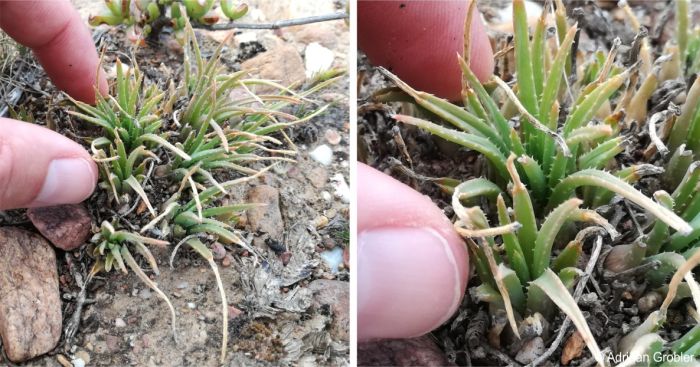
Growing Aloe bowiea
Grow
Aloe bowiea, is a rewarding and interesting subject for those who love succulents. With appropriate care, it does very well in cultivation. Replicating its natural environment is crucial for success. It needs a warm, frost-free environment, and a soil mixture with good drainage, essential for avoiding root rot, a frequent issue for succulents. An ideal choice is a specialized mix for cacti and succulents, or you can make your own by blending standard potting soil with river sand, perlite or pumice in approximately a 1:1 ratio. This guarantees that water flows away rapidly, stopping the roots from being in wet soil.
In the garden, grow it in a sunny position where there is free circulation of air, in well-drained soil, preferably on a slope, and among rocks. Water moderately in summer and lightly in winter. It is ideally suited to frost free thicket, bushveld and coastal gardens. In wet or cold climates it is best grown in a container kept in a greenhouse or indoors, where conditions can be controlled.
In the greenhouse, Aloe bowiea thrives in well-drained soil, and bright indirect sunlight. Although it can handle some direct sunlight, especially in the winter months, extended exposure to intense sun, particularly in summer, can burn its fragile leaves. Additionally, A. bowiea cannot tolerate temperature under 0°C. A bright windowsill or well-lit area in a greenhouse is suitable. Water moderately, drench the pot and then let the soil dry out entirely before watering again. Allow the extra water to drain away, and refrain from leaving the pot in water. Reduce watering during winter.
Being a small aloe that grows at a relatively slow pace, Aloe bowiea does not need to be repotted very often. When the plant gets root-bound, select a suitable pot with drainage holes, that is a bit larger. Spring is the ideal season for repotting, as the plant is starting its active growth phase.
Aloe bowiea plants develop offsets at the base that can easily be removed and replanted to become independent plants. It can also be propagated by seeds sown in spring or summer.
References
- Bhat, R.B. 2013. Plants of Xhosa people in the Transkei region of Eastern Cape (South Africa) with major pharmacological and therapeutic properties. Journal of Medicinal Plants Research 7(20):1474-1480.
- Carter, S., Lavranos, J.J., Newton, L.E. &Walker, C.C. 2011.Aloes The Definitive Guide. Royal Botanic Gardens Kew, Richmond.
- Chen, W., Van Wyk, B.-E., Vermaak, I. & Viljoen, A.M. 2012. Cape aloes – A review of the phytochemistry, pharmacology and commercialisation of Aloe ferox. Phytochemistry Letters 5(1):1-12.
- Glen, H.F. & Hardy, D.S. 2000. Aloaceae (First part): Aloe. In: G. Germishuizen (ed.), Flora of Southern Africa, Vol. 5, Part 1, Fasc. 1: 1–159. National Botanical Institute, Pretoria.
- Grobler, A. 2024. Observations of Aloe bowiea, Eastern Cape. iNaturalist. Online. https://www.inaturalist.org/observations?taxon_id=579592&user_id=adriaan_grobler.
- Guildford Cycads. Aloe bowiea: Bowie’s Aloe- South African Succulent. https://www.guildfordcycads.com.au/aloe-bowiea-bowies-aloe-south-african-succulent/. Accessed 03/01/2025.
- Manning, J. & Goldblatt, P. 2012. Plants of the Greater Cape Floristic Region 1: the Core Cape Flora. Strelitzia 29. South African National Biodiversity Institute, Pretoria.
- Plants of the World Online. Aloe L. https://powo.science.kew.org/taxon/urn:lsid:ipni.org:names:30106039-2. Accessed on 12/02/2025.
- Smith, G.F. & Van Wyk, A.E. 1991. Notes on the pollen morphology and taxonomy of Aloe bowiea (Asphodelaceae: Alooideae). Madoqua 18(2):93-99.
- Smith, G.F. & Van Wyk, B. 2008. Aloes in southern Africa. Struik, Cape Town.
- Smith, G.F. 1990. Nomenclatural notes on the subsection Bowieae in Aloe (Asphodelacee: Alooideae). South African Journal of Botany 56(3):303-308.
- Strydom, L. 2024. Observations of Aloe bowiea, Eastern Cape. iNaturalist. Online. https://www.inaturalist.org/observations?taxon_id=579592&user_id=lucstrydom.
- Van Wyk, B. & Smith, G.F. 1996. Guide to the aloes of South Africa. Briza Publications, Pretoria.
- Von Staden, L., Zikishe, V. & Strydom, L. 2019. Aloe bowiea Schult. & J.H.Schult. National Assessment: Red List of South African Plants. http://redlist.sanbi.org/species.php?species=2206-25.
- Wikipedia. Julius Hermann Shultes. https://en.wikipedia.org/wiki/Julius_Hermann_Schultes. Accessed on 12/02/2025.
Credits
Mahlatse Michelle Malemone & Sicelo Sithole
Karoo Desert National Botanical Garden
and Alice Notten, Kirstenbosch National Botanical Garden
March 2025
Acknowledgements: images of plants in habitat by Adriaan Grobler and Luc Strydom from their observations posted on iNaturalist.
Plant Attributes:
Plant Type: Succulent
SA Distribution: Eastern Cape
Soil type: Sandy, Loam
Flowering season: Early Summer, Late Summer
PH: Acid, Neutral
Flower colour: Brown, Green, White
Aspect: Full Sun
Gardening skill: Easy
Special Features:
Horticultural zones
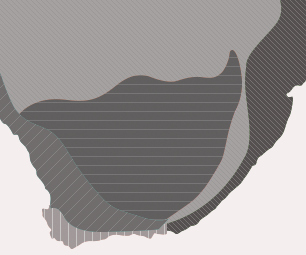







Rate this article
Article well written and informative
Rate this plant
Is this an interesting plant?
Login to add your Comment
Back to topNot registered yet? Click here to register.